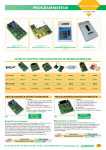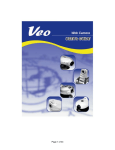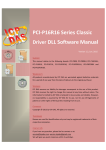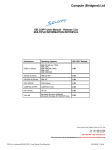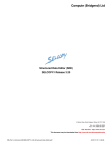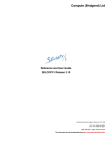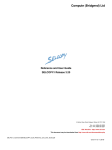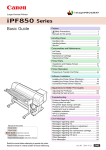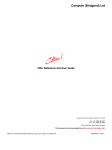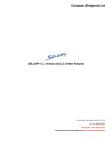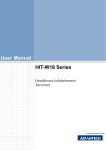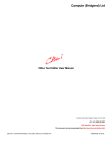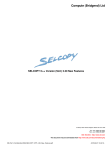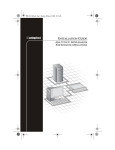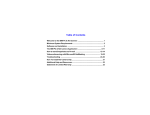Download SELCOPY Product Suite 3.00 New Features - 2010
Transcript
Compute (Bridgend) Ltd
Product Suite New Features
Release 3.00
IBM Mainframe z/OS, VSE & VM/CMS Systems
8 Merthyr Mawr Road, Bridgend, Wales UK CF31 3NH
Tel: +44 (1656) 65 2222
Fax: +44 (1656) 65 2227
CBL Web Site - http://www.cbl.com
This document may be downloaded from http://www.cbl.com/cblidoc.html
CBL Ref: z:\hst\dist\all\SELCOPY_Product_Suite_3.00_New_Features_FrontPage.html
- 2010/12/15 13:11:41 -
SELCOPY Product Suite 3.00 New Features - 2010
Contents
SELCOPY Product Suite 3.00 New Features....................................................................................................................................1
Documentation Notes.............................................................................................................................................................1
SELCOPY Product Suite Components.............................................................................................................................................2
SELCOPY 3.00....................................................................................................................................................................................3
New Facilities & Product Fixes................................................................................................................................................3
Improved Performance on z/OS Sequential Output.........................................................................................................3
Large Blocksize Interface (LBI)........................................................................................................................................3
I/O Buffers >16MB Line...................................................................................................................................................3
VSAM Record Level Sharing (RLS).................................................................................................................................3
VSE CA-EPIC Encrypted Tapes......................................................................................................................................3
CBLVCAT 3.00....................................................................................................................................................................................4
New Facilities & Product Fixes................................................................................................................................................4
TUNE SMS Extended VSAM Enhancements..................................................................................................................4
LISTVTOC TYPE=U - Uncataloged Data Sets................................................................................................................4
LISTVTOC FREE and FREETAB Extents.......................................................................................................................4
SELCOPY/i 3.00..................................................................................................................................................................................5
SELCOPY/i Base....................................................................................................................................................................5
SELCOPY/i Main Window Menu......................................................................................................................................5
SELCOPY/i Ending Prompts............................................................................................................................................5
Message Identification Prefixes.......................................................................................................................................5
SELCOPY Command......................................................................................................................................................5
Local Time Adjustment....................................................................................................................................................6
Panel Windows................................................................................................................................................................6
SDEAMAIN Batch............................................................................................................................................................6
SELCOPY/i DB2 Facilities......................................................................................................................................................7
SELCOPY/i DB2 Panels..................................................................................................................................................7
DB2 Audit Logs................................................................................................................................................................8
DB2 Edit & Browse..........................................................................................................................................................9
DB2 Objects...................................................................................................................................................................11
DB2 Command Execution..............................................................................................................................................12
SELCOPY/i File Copy Utility - FCOPY..................................................................................................................................13
SELCOPY/i File Search, Update & Copy Utility - FSU..........................................................................................................16
SELCOPY/i Favourites Panel - FAV.....................................................................................................................................18
SELCOPY/i Find Library Members Utility - LLX....................................................................................................................19
SELCOPY/i Compare File Utility - COMPFILE.....................................................................................................................20
SELCOPY/i Compare Library Utility - COMPLIB..................................................................................................................22
SELCOPY/i Text Editor - CBLe.............................................................................................................................................23
SELCOPY/i Structured Data Editor - SDE............................................................................................................................24
SELCOPY/i Lists...................................................................................................................................................................26
SELCOPY/i 1.80 Zaps applied..............................................................................................................................................27
2010/12/15 18:09:11
i
SELCOPY Product Suite 3.00 New Features
Documentation Notes
Information in this New Feature List details changes introduced to CBL software since the last generally available releases of
SELCOPY, SELCOPY/i and CBLVCAT.
The SELCOPY Product Suite for z/OS, z/VM (CMS) and z/VSE operating systems, which includes SELCOPY, SELCOPY/i and
CBLVCAT, is available for download and install from http://www.cbl.com/selcdl.html.
The following publications for SELCOPY Product Suite and its component products are available in Adobe Acrobat PDF format at
CBL web page http://www.cbl.com/selcdoc.html:
• SELCOPY Product Suite Customisation Guide
• SELCOPY User Manual
• CBLVCAT User Manual
• SELCOPY/i Reference and User Guide
• SELCOPY/i Text Editor (CBLe) Manual
• SELCOPY/i Structured Data Editor Manual
Copyright in the whole and every part of this document and of the SELCOPY Products Suite system and programs, is owned by
Compute (Bridgend) Ltd, whose registered office is located at 8 Merthyr Mawr Road, Bridgend, Wales, UK, CF31 3NH, and who
reserve the right to alter, at their convenience, the whole or any part of this document and/or the SELCOPY Product Suite system
and programs.
No reproduction of the whole or any part of the SELCOPY Product Suite system and programs, or of this document, is to be made
without prior written authority from Compute (Bridgend) Ltd.
At the time of publication, this document is believed to be correct. CBL do not warrant that upward compatibility will be maintained
for any use made of this program product to perform any operation in a manner not documented within the user manual.
The following generic terms are used throughout this document to indicate all available versions and releases of IBM mainframe
operating systems:
MVS - z/OS, OS/390, MVS/ESA, MVS/XA, MVS/SP, OS.
VSE - z/VSE, VSE/ESA, VSE/SP, DOS.
CMS - z/VM, VM/ESA, VM/XA, VM/SP.
All
- All MVS, VSE and CMS operating systems.
2010/12/15 18:09:11
SELCOPY Product Suite 3.00 New Features - 2010
1
SELCOPY Product Suite Components
Since the introduction in 2004 of the SELCOPY interactive interface, CBLi (later rebranded SELCOPY/i), the set of programs
supplied as part of the SELCOPY licence has expanded to more than just the single executable, SELCOPY.
In order to reflect this growing number of programs and to avoid confusion amongst end users, the CBL software offering to
licensees of SELCOPY and/or CBLVCAT has been combined into a single installable bundle entitled the SELCOPY Product Suite.
Note that an appropriate, valid SELCOPY and/or CBLVCAT licence key is required to execute related components of the
SELCOPY Product Suite.
The release number of all SELCOPY Product Suite components has been unified at release 3.00.
The SELCOPY Product Suite comprises the following software components:
SELCOPY
A universal batch information retrieval utility language for multiple sequential data set, VSAM, PDS/PDSE member, VSE
LIBR member and DB2/IMS/ADABAS database input/output. Features include conditional syntax; test data generation;
report generation; data manipulation, matching, merging, conversion, arithmetic and update.
CBLVCAT
Batch utility for VSAM cluster tuning, re-organisation and IDCAMS DEFINE job generation; standard and customised
ICF/VSAM cataloged data set reporting and VTOC contents display.
SELCOPY/i
An interactive windowed environment operating within a 3270 terminal under ISPF, TSO, CMS or as a VTAM application.
The SELCOPY/i environment includes a compendium of tools and facilities some of which are listed below:
◊ Function rich text editor with both ISPF Edit and XEDIT compatibility.
◊ Structured data editor supporting COBOL and PL1 Copybooks.
◊ DB2 table editor. (*)
◊ DB2 SQL execution.
◊ List facility includes DB2 objects, Datasets, DASD Volumes, VTOC files/extents, HFS files and ENQs.
◊ File Search and Update including support for copybook map.
◊ File Copy supporting mixed data set organisations and copybook remap. (*)
◊ File and PDS/PDSE library Compare. (*)
◊ SELCOPY interactive development environment and debugger.
◊ CBLVCAT interactive reports and VSAM data set tuning.
Items marked (*) are new in this release.
SDEAMAIN
A SELCOPY/i program to execute a selection of Structured Data Edit (SDE) commands in a batch environment.
SDEAMAIN requires allocation of SDEIN and SDEPRINT to specify input commands source and list output respectively.
SDE commands that may be executed by SDEAMAIN are:
◊ FSU - File Search and Update.
◊ FCOPY - File Copy.
◊ CREATE STRUCTURE - Create a SELCOPY/i internal structure (SDO) from a COBOL or PL1 Copybook.
SLC
The SELCOPY batch utility developed in C++ for UNIX and PC platforms and now compiled for zVM CMS and z/OS
systems. Although it is not yet a replacement for SELCOPY, SLC supports additional SELCOPY syntax and features that
warrant its inclusion in this release of SELCOPY Product Suite.
In particular, the READ LIST facility may be used to generate and optionally process contents of SELCOPY/i list windows
(e.g. dataset, VTOC lists) in a batch environment.
READ LIST and other features specific to SLC are not yet documented in full, however, a synopsis may be obtained from
the CBL FTP site at:
ftp://ftp.cbl.com/All/SNF300c.txt
2010/12/15 18:09:11
SELCOPY Product Suite 3.00 New Features - 2010
2
SELCOPY 3.00
New Facilities & Product Fixes
Support for following has been included in SELCOPY release 3.00:
Improved Performance on z/OS Sequential Output
SELCOPY uses system supplied routines to perform device independent I/O.
In previous releases, output data blocking to non-VSAM datasets was allowed to default to that performed automatically
by the queued sequential access method (QSAM). In SELCOPY release 3.00, the default is to use basic sequential
access method (BSAM) on output to non-VSAM datasets whereby blocking is performed by SELCOPY.
The net result is reduced CPU usage on output to non-VSAM data sets.
Large Blocksize Interface (LBI)
Allocation of data sets on specific devices (TAPE and DUMMY) supports specification of BLKSIZE>32K. This feature was
introduced by IBM with support for the Large Blocksize Interface (LBI) in versions of z/OS 1.8 and later, and on previous
versions with IBM tolerance APAR OA09869 applied. For tape devices, the blocksize value is recorded in tape HDR2
labels.
For data sets on tape devices where BLKSIZE>32K is specified, SELCOPY uses LBI to successfully read or write data
records.
I/O Buffers >16MB Line
For SMS managed, extended format data sets with ACCBIAS=SYSTEM or RMODE=BUFF, I/O buffers are obtained from
above the 16MB line.
Although an AMODE=24 program, SELCOPY now supports above the line I/O buffers where WORKLEN is also
specified.
VSAM Record Level Sharing (RLS)
SELCOPY performs successful I/O on VSAM data sets that employ a level of record-level sharing (RLS). See "z/OS
DFSMS Using Data Sets" and "z/OS DFSMSdfp Storage Administration" for information on VSAM RLS access.
VSE CA-EPIC Encrypted Tapes
OEM product CA-EPIC on VSE systems supports encryption of data written to tape files.
By default, SELCOPY opens VSE tape input data sets as RECFM=U in order to verify specification of a suitable
BLKSIZE. In order to successfully read CA-EPIC encryted tape files, so that data is automatically decryted on input, the
CBLNAME option STapeInpLIOC=YES has been introduced to force SELCOPY to use standard LIOCS for tape.
Note that DEV=TAPE must be specified on the tape input READ statement if fname (TLBL/CA-EPIC DDNAME) is not of
the format TAPEnn.
2010/12/15 18:09:11
SELCOPY Product Suite 3.00 New Features - 2010
3
CBLVCAT 3.00
New Facilities & Product Fixes
Support for following has been included in CBLVCAT release 3.00:
TUNE SMS Extended VSAM Enhancements
CBLVCAT tuning recommendations for VSAM SMS extended data sets have been enhanced to correctly identify the
current and optimum physical record size and so report the most efficient values for data and index CISIZE, and other
IDCAMS attributes.
CBLVCAT VSAM SMS extended data set tuning recommendations are also accurate for VSAM data sets defined with
COMPACTION and/or EXTENDED ADDRESSABILITY Data Class attributes.
LISTVTOC TYPE=U - Uncataloged Data Sets
The LISTVTOC TYPE=U subset parameter has been introduced to filter a VTOC report to display onlu uncataloged data
sets.
LISTVTOC FREE and FREETAB Extents
LISTVTOC FREE and FREETAB options display extents of free space on a DASD volume. CBLVCAT has been updated
to successfully report free space extents that exist on relative volume cylinder number > 9999.
2010/12/15 18:09:11
SELCOPY Product Suite 3.00 New Features - 2010
4
SELCOPY/i 3.00
SELCOPY/i Base
The following changes have been implemented in the SELCOPY/i release 3.00 base environment:
SELCOPY/i Main Window Menu
Since support was introduced in SELCOPY/i 1.30 for non-edit child window views in the CBLe Text Editor, the course of
SELCOPY/i product development has increasingly relied upon the user working solely within the text edit or SELCOPY
debug applications.
Because of this, the text edit application is always started by default when the user invokes SELCOPY/i and the user's
HOME command centre file displayed in an edit window view. This provides the user with the suitable platform for
starting any of the available SELCOPY/i features.
Since executing menu options from outside of a text editor environment was no longer desirable, in SELCOPY/i 1.60, all
main window menu items were duplicated in the SELCOPY/i text editor parent window and the main window items
obscured by the maximised text editor. This meant that the main window menu items were no longer selectable unless
the user exited or reduced the size of the text editor parent window.
To prevent the user from selecting menu items from outside a text edit environment, the SELCOPY/i menu items have
now been removed and replaced with a single item "Home" which starts the text editor (if not already started) and once
again displays the user's HOME command centre.
SELCOPY/i Ending Prompts
Due to customer requests, the warning pop-up message windows that prompt the user to continue with an END operation
has been disabled for the following:
• Closing the "Home" command centre edit view.
• Ending the SELCOPY/i environment.
Note that ISPF style AUTOSAVE command exist for both text edit and SDE edit window views to determine the action of
an END command (assigned by default to <PF3>) when unsaved alterations to the data exist. ISPF style CANCEL
command is also supported.
Message Identification Prefixes
In order that message identification numbers are unique and do not conflict with message numbers assigned to non-CBL
products, all SELCOPY/i message ID prefixes have been modified to adopt the registered three character SMP/E
SELCOPY/i product component ID (ZZS) as follows:
SELCOPY/i 1.80
SELCOPY/i 3.00
EDTxxxx
ZZSExxxx
IOSxxxx
ZZSIxxxx
SDExxxx
ZZSDxxxx
VCIxxxx
ZZS0xxxx
VTMxxxx
ZZSVxxxx
WINxxxx
ZZSWxxxx
SELCOPY Command
The minimum abbreviation of the line command, SELCOPY, which invokes the SELCOPY Interactive Development
(Debug) application has been changed from "S" to "SELC". This prevents confusion with the List window prefix command
"S" which selects the default action for a list entry.
Command SELCOPY (or any of its valid abbreviated forms) may be entered in the prefix area of a file list to invoke the
SELCOPY Debug application using the selected entry as SYSIN input.
2010/12/15 18:09:11
SELCOPY Product Suite 3.00 New Features - 2010
5
SELCOPY/i 3.00
Local Time Adjustment
Local Time Adjustment
Whenever current data and time is required, SELCOPY/i performs a store clock function to obtain the CPU clock and
converts this to the required date format.
SELCOPY/i 3.00 applies the system's customised time zone adjustment to obtain and report local, instead of UTC,
current date and time values.
Panel Windows
SELCOPY/i 3.00 introduces a new, more advanced mechanism for the display of dialog windows (panels). In addition to
the new DB2 panel windows, many existing dialog windows (e.g. File Copy, File Search & Update) have been converted
to use this new panel mechanism.
All panel windows share the following features which distinguish them as being superior to dialog windows used in
previous releases of SELCOPY/i:
• Resizing of the panel display window using standard SELCOPY/i window resizing techniques. The line numbers
on display and the total number of lines in the panel window is displayed beneath the "Scroll>" field.
• Up/Down scrollable display of the panel content as required for panel resizing and for 3270 terminals with a low
number of displayed rows. This allows the content of the panel to extend beyond the depth of the panel window.
Use the "Scroll>" input field to control scrolling type as described in SDE editor help for UP and DOWN
command.
Scroll up and down using <PF7> and <PF8> respectively.
• The last customised position and size of a panel window is stored and used the next time the panel is opened.
This applies across consecutive SELCOPY/i sessions.
• Panel windows are non-modal so focus can be placed on other display windows without first having to close the
panel window. This also means that a dialog panel window may persist beyond the end of the execution of the
panel functions. e.g. Favourites (FAV) window, used as a method for fast data set edit and command execution,
no longer closes following the selection of an item.
• Scrollable and expandable input fields which allow input of more text than can be displayed in the field area.
These type of input fields are suffixed with a plus and/or minus sign which also provides an indication as to
whether the current displayed data is at the start ("+") or end ("-") of the field, or somewhere in between ("-/+").
The entire contents of the field may be expanded into a text edit view and so edited using full text editor
functionality, before being placed back in the input field when the text edit view is closed.
With the cursor positioned within the scrollable field, scroll left and right using <PF10> and <PF11> respectively,
and expand the field using <PF2>.
• The last entry in a panel input field before it is closed is stored and may be recalled at any time by the user to
populate the same input field of the panel on subsequent invocations.
With the cursor positioned within the input field, recall the last entry for that field using <PF4>.
SDEAMAIN Batch
The program, SDEAMAIN, is included to enable batch execution of select SDE commands; FSU, FCOPY, CREATE
STRUCTURE and QUERY. SDEAMAIN requires allocation of SDEIN and SDEPRINT to specify input commands source
and list output respectively.
SDEIN input must exist between columns 1-72. Syntax of a command wraps at column 72 to column 1 of the next SDEIN
record and ends at the first unquoted occurrence of a semi-colon (";") or at end of SDEIN. Multiple SDE commands may
be specified in a single execution of SDEAMAIN.
SDEPRINT output is RECFM=FBA/VBA, LRECL=133.
....+....1....+....2....+....3....+....4....+....5....+....6....+....7....+....8
//STEP01 EXEC PGM=SDEAMAIN,REGION=0M
//SDEPRINT DD SYSOUT=*
//SDEIN
DD *
FCOPY CBL.DIST.SMPE.ZZS.SAM1(ZZSDB2B)
NBJ.ZZSDB2B.PDS
REPL
ACE;
FCOPY
CBL.DIST.SMPE.ZZS.SAM1(ZZSDB2B)
NBJ.ZZSDB2B
/*
2010/12/15 18:09:11
SELCOPY Product Suite 3.00 New Features - 2010
6
SELCOPY/i 3.00
SELCOPY/i DB2 Facilities
SELCOPY/i DB2 Facilities
Introduction of support for DB2 data base facilities is the most significant addition to SELCOPY/i in release 3.00. SELCOPY/i DB2
facilities are incorporated within the base product and do not require any additional licensing over and above the SELCOPY
product key.
SELCOPY/i users may connect to any local or remote DB2 subsystem for which the SELCOPY/i DB2 plan has been bound and the
user granted EXECUTE authority. For successful operation, users must also be granted SELECT access to the subsystem's DB2
catalog tables and, if configured, READ access to the SELCOPYI.DB2 SAF resource. See the "SELCOPY Product Suite
Customisation Guide" for details on enabling SELCOPY/i DB2.
SELCOPY/i DB2 Panels
All DB2 related features may be accessed via the suite of SELCOPY/i DB2 panels started by selecting the "DB2"
drop-down menu item of the "File" main menu, or by executing the DB2 CLI command. Note that SELCOPY/i panels are
window objects within SELCOPY/i and should not be confused with ISPF panels.
DB2 Primary Option Menu
The DB2 Primary Option Menu panel is the entry point to all SELCOPY/i DB2 panels which provide all available DB2
functionality available in SELCOPY/i.
On selecting an item from this menu panel, or if a PFKey/<Enter> is hit, then an attempt is made to connect to the DB2
subsytem specified in the SSN field. If the SSN field is subsequently changed, the connection is dropped and a connection
to the new DB2 subsystem is attempted. If the user wants to work with multiple DB2 subsystems concurrently, then a DB2
primary option menu panel must be opened to perform a connection to each subsystem.
If Create Audit File is selected, an audit log file will be allocated immediately before attempting to connect to the DB2
subsystem and closed when the connection is dropped. Separate connections and audit files are maintained for each
results table edit in order to isolate table updates.
Panels supported in SELCOPY/i DB2 3.00 are:
◊ Execute DB2 Commands.
◊ Execute DB2 SQL Statements.
◊ Edit DB2 results table.
◊ Browse DB2 results table.
◊ Create DB2 Objects.
(Storage group, Work File Database, User Database, View, Alias, Synonym, Type, Trigger, Sequence, Role.)
◊ Drop DB2 Objects.
(Storage group, Database, Table space, Table, View, Alias, Index, Synonym, Type, Function, Stored
procedure, Trigger, Global temporary table, Sequence, Role, Trusted context.)
◊ List DB2 Objects.
(Storage groups, Databases, Table spaces, Tables, Views, Aliases, Indexes, Synonyms, Types, Triggers,
Global temporary tables, Sequences, Roles, Trusted contexts, Columns, Volumes.)
◊ Audit Log Functions.
1. Audit Log Dataset Options.
2. Print Audit Report.
3. List Audit Datasets.
Figure 1. DB2 Primary Option Menu Panel.
2010/12/15 18:09:11
SELCOPY Product Suite 3.00 New Features - 2010
7
SELCOPY/i 3.00
SELCOPY/i DB2 Panels
DB2 CLI Command
Syntax:
+--------------------------------------------------+
v
|
>>-- DB2 ------+-------------------------+---+--------------+--+-------------><
|
|
|
|
| +-------------------+ |
+-- fastpath --+
| v
| |
+---- fieldname=value -+--+
Description:
Display the SELCOPY/i DB2 primary option menu panel and, optionally, nested sub-panels. If a fast path is specified or, if
no fast path is specified but a value is specified for field SSN (SSN=xxxx), then a DB2 connection is performed
automatically. In all other cases, no DB2 connection is attempted until the user hits <Enter> (or any PFKey) to accept the
DB2 SSN and SQLID displayed in the DB2 primary option menu panel.
Parameters:
fastpath
Each SELCOPY/i DB2 panel may be accessed via one or more levels of nesting into menu panels. Fast path
menu item selection allows immediate nesting into panel menus to open the required SELCOPY/i DB2 panel
without the need to select menu items individually.
Note that each nested panel in the fast path will be displayed. Furthermore, a connection to the specified
subsystem (SSN=xxxx) or the last accessed or default DB2 subsystem, will occur automatically with SQLID set to
the corresponding value in the DB2 primary option menu panel.
fastpath is an integer value representing a menu choice. If no update of input fields (fieldname=value) is to be
performed between successive fastpath values, then successive fastpath values may be separated by a single
dot/period (.) without intervening blanks. e.g. DB2 7.1
fieldname=value
fieldname nominates a field name within the current nested DB2 panel, into which the corresponding value will be
inserted. If value contains special characters or blanks, then it must be contained within apostrophes (') or
quotation marks (").
A separate fieldname=value combination may be specified for each input field in the resulting panel.
Beware that specifying a fast path in addition to a fieldname=value combination will immediately execute the
command assigned to the resultant panel. e.g. CREATE STOGROUP, DROP TABLE.
Examples:
DB2
5
Open the CREATE Object option panel.
DB2
SQLID=NBJ002
Open the DB2 primary option menu panel and insert "NBJ002" in the SQLID field. Connection will not occur
when the panel is opened until <Enter> or a PFKey is hit.
DB2
SSN=DB2B
1
DB2CMD="-DISPLAY BUFFERPOOL(BP1)"
Open the DB2 primary option menu panel, insert "DB2B" in the SSN field and perform DB2 connect. Then open
the DB2 Command panel, insert "-DISPLAY BUFFERPOOL(BP1)" in the DB2CMD field, and immediately
execute the command to display a list of DB2 buffer pools.
DB2
SSN=DB2C
7.1
NAME=DSN%
Open the DB2 primary option menu panel, insert "DB2C" in the SSN field and perform DB2 connect. Then open
the List Storage Groups panel, insert "DSN%" in the NAME field, and immediately execute to display a list of
storage groups with name beginning "DSN".
DB2 Audit Logs
SELCOPY/i DB2 supports the generation of audit log data sets that record all SQL activity occurring during a DB2
connection. Unless logging is deactivated, a single audit log data set is automatically allocated for each DB2 connection.
Only SQL commands executed via this connection will be logged in the audit file.
Except for DB2 edit which maintains a separate log file for each table edited, a DB2 connection and log file will be
generated once for each execution of the DB2 primary option menu panel.
Users may choose to maintain a log data set via a flag in the DB2 primary option menu panel or, for table edit, a flag in
the Edit Object panel or the AUDIT parameter of the SDE Edit line command. Data set options, used by SELCOPY/i to
allocate a new log data set, may be customised via the Audit Log Dataset Options panel (fast path 8.1).
2010/12/15 18:09:11
SELCOPY Product Suite 3.00 New Features - 2010
8
SELCOPY/i 3.00
DB2 Audit Logs
The Audit Functions panel provides facilities for listing and printing Audit data sets. Printing an audit first processes the
formatted records of the audit log file to generate a printable report. This may be executed in the foreground to display
the report in a text edit window view or a batch job may be generated.
An alternative to using the Print Audit Report panel, the report may be generated in the foreground by entering
AUDPRINT in the prefix area against an entry of the audit dataset list.
DB2 Edit & Browse
SELCOPY/i DB2 in-storage edit and browse of DB2 results tables uses the already available SDE structured data editor.
The SDE editor already supports display of formatted data using copybooks and internally defined structures, and so has
now been modified to inernally generate a structure (SDO) using the DB2 SQLDA chain for the results table columns. All
existing features of the SDE editor including FIND, CHANGE, WHERE and LOCATE are automatically available for DB2
table edit/browse.
Changes to the SDE edit and browse window views for DB2 tables are:
1. Abbreviated forms of the standard DB2 datatypes are displayed in the field type header line instead of the SDE
field datatype, position and length. Display of this header line is controlled using SET TYPE ON/OFF.
2. The addition of an SQLCode record information field for DB2 which may be displayed and hidden using SET
RECINFO SQLCODE/NOSQLCODE or selecting option 2 in the DB2 Browse/Edit Utilities manu (<PF4>).
In addition to applying column select, row sort and filter options (SELECT, WHERE and ORDER BY clauses) to the DB2
table (or view), the user may specify concurrency (isolation level) and table locking options as well as options to skip
display of rows that have already been locked and when COMMIT should be executed for changed data.
DB2 Edit & Browse Object Panels
The DB2 Edit Object and Browse Object Panels are displayed on selecting the "Edit" and "Browse" options of the DB2
Primary option menu panel respectively.
Figure 2. DB2 Edit Object Panel.
Input fields in each of the DB2 Edit and Browse panels reflect the DB2 input parameters supported by their equivalent
SDE line commands, EDIT and BROWSE. With the exception of COMMIT, table locking, skipping locked rows and
concurrency options, which are applicable to edit only, Edit and Browse Object panels support the same input fields. See
2010/12/15 18:09:11
SELCOPY Product Suite 3.00 New Features - 2010
9
SELCOPY/i 3.00
DB2 Edit & Browse
"DB2 options for SDE EDIT and BROWSE CLI Commands"
Having configured the input fields, select "Run" from the menu bar or hit <Enter> to execute the edit/browse. For edit
only, a new connection is made to the DB2 subsystem specified on the DB2 Primary option menu panel and, optionally, a
new audit log data set is allocated. This isolates actions specific to that DB2 object edit from all other DB2 actions and
object editing.
The "Command" menu bar item will display in a text edit view the SDE EDIT or BROWSE commands generated for the
selected input field values.
DB2 options for SDE EDIT and BROWSE CLI Commands
Syntax:
>>- EDIT --+-- file-name --------------------------------------------------+-><
|
|
+-- DB2 --+---------+--+- table-name -+--+-------------------+--+
|
| |
| |
|
+- (ssn) -+ +- view-name --+ +- | DB2 Options | -+
DB2 Options:
>>--+-------------------------+--+--------------------------+--+---------+--->
|
| |
| |
|
+- FROM --+-------+-- n --+ +- FOR -- n_rows -+--------+ +- AUDit -+
|
|
|
|
(1)
+- ROW -+
+- ROWS -+
>--+--------------------------+--+------------------------+----------------->
|
| |
|
+- SELect (select-clause) -+ +- WHERE (where-clause) -+
>--+------------------------------+---+--------------+--+----------------+-->
|
|
|
| |
|
+- ORDER -+- (orderby-clause) -+
+- SKIPLocked -+ +- EDITPRIMEKEY -+
|
|
(1)
(1)
+- SORT --+
+- COMMITONCLEANSAVE -+
|
|
>--+------------------------------------------+---+---------------------+--->
|
|
|
|
+- WITH -+- CS ----------------------------+
+- COMMITONSAVE ------+
(1)
|
|
|
|
+- UR ----------------------------+
+- COMMITONEXIT ------+
|
| (1)
+- RR --+-+-----------------------+
|
| |
|
+- RS --+ +- KEEP -+-- EXclusive -+
|
|
+-- UPDate ----+
|
|
+-- SHR -------+
>--+---------------------------+---+----------------+-----------------------><
|
|
|
|
+- LOCKTABLE -+- EXclusive -+
+- COMMITONLOAD -+
(1)
|
|
(1)
+- SHr -------+
Notes:
(1) Applicable to EDIT command only.
Description:
Open an SDE window view to edit or browse row data of a DB2 results table. A DB2 connection is made and, optionally, a
new audit log allocated for each new SDE EDIT command executed on a DB2 table or view.
Note that, in release 3.00, only in-storage edit/browse is supported. Therefore, if a results table is too large to be loaded
into available storage a storage error occurs. The user must then restrict the number of rows to be loaded using further
row selection criteria (i.e. FROM, FOR, SELECT, WHERE parameters).
Parameters:
FROM ROW n
Equivalent to FROM RECORD n, this defines the number of the row returned from the generated SQL select
statement to be displayed first in the browse/edit window. All previous rows are skipped.
Default is row 1.
FOR n_rows ROWS
Equivalent to FOR n_recs RECORDS, this defines the maximum number of rows eligable to be displayed in the
browse/edit window following execution of the generated SQL select statement with any WHERE clause applied.
All selected rows that fall outside this scope are skipped.
Default is to display all selected rows.
2010/12/15 18:09:11
SELCOPY Product Suite 3.00 New Features - 2010
10
SELCOPY/i 3.00
DB2 Objects
SELECT (select-clause)
Specifies a DB2 SQL SELECT clause to be include in the generated SQL select statement. See "DB2 SQL
Reference" for details on the select-clause.
WHERE (where-clause)
Specifies a DB2 SQL WHERE clause to be include in the generated SQL select statement. See "DB2 SQL
Reference" for details on the where-clause.
SORT|ORDER BY (order-by-clause)
Specifies a DB2 SQL ORDER BY clause to be include in the generated SQL select statement. See "DB2 SQL
Reference" for details on the order-by-clause.
WITH CS|UR|RR|RS
< KEEP EXCLUSIVE|UPDATE|SHR >
Specifies a DB2 SQL isolation-clause to be included in the generated SQL select statement. See "DB2 SQL
Reference" for details on the effects of isolation level on the generated select statement.
The KEEP sub-parameter options are applicable to isolation levels RR (Repeatable Read) and RS (Read
Stability) only.
Default isolation level (as set by the SELCOPY/i DB2 package and plan BIND) is CS.
SKIPLOCKED
Specifies that any selected rows that are already locked by another process should not be included in the edit
display.
Default is to allow display of locked records whenever possible.
EDITPRIMEKEY
Allows update of data belonging to any column that constitutes the table's prime key.
Default is that prime key columns are read only.
COMMITONCLEANSAVE | COMMITONSAVE | COMMITONEXIT
Specifies when a COMMIT should be executed for changed data.
• COMMITONCLEANSAVE - COMMIT only if SAVE is executed without errors.
• COMMITONSAVE - COMMIT on SAVE regardless of errors.
• COMMITONEXIT - COMMIT only on exit of the edit session.
Default is COMMITONCLEANSAVE.
LOCKTABLE EXCLUSIVE|SHR
For DB2 tables (not views) only, executes a DB2 SQL command LOCK TABLE before loading data from the
table. Use this option with caution as other users and applications may be prevented from accessing the table.
See "DB2 SQL Reference" for details on the effects of LOCK TABLE options.
Default is not to perform any explict table locking prior to load. (Recommended)
COMMITONLOAD
Perform a COMMIT following the initial load of rows to be edited, thus releasing all DB2 table locks performed
during load of the data. This includes any explicit table locks applied via the LOCKTABLE parameter.
Default is not to perform a COMMIT following load of the table rows.
DB2 Objects
SELCOPY/i 3.00 includes support for panels that provide users with an interface to generate and execute SQL CREATE,
DROP and LIST commands for selected DB2 objects.
DB2 Create and Drop object panels include the following menu items:
Run
Immediately executes the generated SQL command.
the generated SQL command in a text edit view in a format suitable for execution using
Command Display
CMDTEXT. (i.e. place the cursor on the first line of the command and hit <PF4>)
Create sample JCL that will run DSNTIAD for the generated SQL command and display it in a text
JCL
edit view. The job may be customised then submitted to batch using the SUBMIT line command.
DB2 List object panel input fields support standard DB2 wild cards to apply a filter before the rows are fetched. The list
panel also includes the same features as supported for standard file list windows:
• Line commands (e.g. SELECT, WHERE and SORT) for column selection, sort and filter of current list data.
• Prefix commands with default action. Enter "/" against a list entry (or hit <PF4>) to display a table of supported
prefix commands and their descriptions.
• Point-and-shoot on a list column header to sort list entries ascending/decending on that column.
• Display the contents of a single list row entry vertically in a separate window. (Hit <PF2>)
2010/12/15 18:09:11
SELCOPY Product Suite 3.00 New Features - 2010
11
SELCOPY/i 3.00
DB2 Command Execution
• Menu bar items:
Open a drop-down menu of all previous (SELECT, WHERE, SORT) views of the listed data for
selection by the user.
Refresh Refresh the current display of listed data.
Back
Return to the previous (SELECT, WHERE, SORT) view of the listed data in the chain.
Forward Proceed to the next (SELECT, WHERE, SORT) views of the listed data in the chain.
FDB
Display information (e.g. offset, length, data type) about each column in the list.
Text
Display the column headers and contents of the current list in a text edit view.
View
Figure 3. DB2 List Tables Panel.
DB2 Command Execution
DB2 commands may be executed from the Execute DB2 Commands panel accessible via the "DB2" item of the DB2
Primary option menu panel.
Figure 4. Execute DB2 Commands Panel.
The "Byte Limit" input field defines the DB2 command's output data buffer size limit. If set to 0 (zero), then there is no
limit to the output buffer size. The output from the DB2 command is displayed in the panel's scrollable output display
area.
The output report contains the DB2 command executed; the return and reason code received on execution of the DB2
command; the instrumentation facility interface (IFI) return and reason code; and the number of bytes returned/not
returned. If number of bytes not returned is greater than zero, then this value indicates the amount of additional buffer
space required to display the complete output from the command.
2010/12/15 18:09:11
SELCOPY Product Suite 3.00 New Features - 2010
12
SELCOPY/i 3.00
SELCOPY/i File Copy Utility - FCOPY
SELCOPY/i File Copy Utility - FCOPY
The File Copy utility is an advanced data set copy tool that supports:
• Direct copy between data sets of different data set organisations and record formats. (PDS/PDSE member(s), Sequential,
KSDS, ESDS and RRDS.)
• Copying a subset of records starting at a specified record, identified by a record number, KSDS key or ESDS RBA, for a
fixed number of records.
• New in release 3.00, the File Copy dialog window is now a panel window. (See "Panel Windows").
• New in release 3.00, specification of a pad character used to pad a short record that is copied to a longer fixed format
record. (e.g. ESDS to RECFM=F; RECFM=V to RRDS; RECFM=F LRECL=80 to RECFM=F LRECL=100).
• New in release 3.00, use of "From" and "To" structures to map fields in records of the "From" and "To" data sets. These
structures may be a mix of SDE structures, COBOL Copybook or ADATA files or PL/1 Copybook or ADATA files.
Structures define the names of one or more record mappings (SDE record types) where each record type typically
contains multiple field names.
Where a record in the "From" data set is mapped by a record type defined in the "From" structure, then data within that
record will be copied to a record in the "To" data set that will be mapped using a record type of the same name existing in
the "To" structure. If this record type does not exist in the "To" structure, then the "From" record will be copied unchanged.
Only data mapped to fields with a field name that exists in both the "From" and "To" record types will be copied. All other
data fields in the "From" data set will by ignored. Unreferenced fields in the "To" record type will be initialised to their
default value. i.e. blanks for character fields and 0 (zero) for numeric fields.
The location of a named data field within the "To" record type does not have to match that of the equivalent field name in
the "From" record. Similarly, so long as conversion between data types can occur without error, the data type, length,
precision and scale of the "To" field does not have to match that the "From" field. Therefore, the record may be easily
restructured so that fields are output in a different order and can also be of a different data type.
• New in release 3.00, the "Job" menu bar item generates JCL that executes program SDEAMAIN (see "SDEAMAIN
Batch") with an FCOPY line command passed via SDEIN. This allows support for the copybook features already
mentioned. In previous releases, a JCL deck was generated that executed program SELCOPY.
Figure 6. File Copy Dialog.
FCOPY CLI Command Changes
Syntax:
>>-- FCopy -----------+-------------------+----------------------------------><
|
|
+- |CLI Options | --+
2010/12/15 18:09:11
SELCOPY Product Suite 3.00 New Features - 2010
13
SELCOPY/i 3.00
SELCOPY/i File Copy Utility - FCOPY
CLI Options:
>>-- from_dataset ------+--------------------------------------------+------->
|
|
|
+- SDO ---+
|
|
|
|
|
+- USING -+---------+-- from_using_dataset --+
+- COBOL -+
+- PL1 ---+
+- ADAta -+
>-- to_dataset --------+--------------------------------------------+------->
|
|
|
+- SDO ---+
|
|
|
|
|
+- USING -+---------+---- to_using_dataset --+
+- COBOL -+
+- PL1 ---+
+- ADAta -+
>--+-------------------------+-+----------------------+-+-----------------+->
|
| |
| |
|
+- STARTKEY -- start_key -+ +- STOPAFT -+- n_recs -+ +- FILL -+- char -+
|
| |
|
|
|
+- STARTRBA -- start_rba -+ +--FOR -----+
+- PAD --+
|
|
+- STARTREC +- start_rec -+
|
|
+- FROM ----+
>--+----------+--+---------+--+----------+--+---------+--+-------+----------><
|
| |
| |
| |
| |
|
+- APPend -+ +- JCL ---+ +- REPlace + +- Quiet -+ +- NEW -+
|
|
+- BATch -+
Description:
Open the File Copy panel window, create an SDEAMAIN batch job deck for FCOPY or invoke file copy to execute the
copy directly.
Parameters:
from_dataset
The full DSN of the source data set or library to be copied.
For PDS/PDSE libraries, multiple member masks supporting wildcard characters "*" (representing zero or more
characters) and "%" (representing exactly one character) may be specified in parentheses "( )" following the
library DSN. If a library DSN is specified without a member mask, then a member mask of (*) is assumed. i.e. all
members.
USING SDO|COBOL|PL1|ADATA from_using_dataset
The DSN and format of a structure (SDE structure; COBOL Copybook or ADATA file; PL/1 Copybook or ADATA
file) to be used to map record data in from_dataset.
If USING is specified, then SDO is default.
to_dataset
The full DSN of the destination data set or library member.
The data set organisation and record format (RECFM) may be different to that of from_dataset. If from_dataset is
a library and to_dataset is not, then records from all selected members will be copied to the single destination
data set.
If from_dataset contains a library member mask, then to_dataset cannot reference a single library member.
USING SDO|COBOL|PL1|ADATA to_using_dataset
The DSN and format of a structure (SDE structure; COBOL Copybook or ADATA file; PL/1 Copybook or ADATA
file) to be used to map output record data for to_dataset.
If USING is specified, then SDO is default.
STARTKEY start_key
For KSDS source data set only, specifies the key (or partial key) of the first record to be copied.
STARTRBA start_rba
For ESDS source data set only, specifies the RBA (relative byte address) of the first record to be copied. This
may be in hex or decimal format. (e.g. X'0115' and 277 are equivalent.)
STARTREC|FROM start_rec
Specifies the record number of the first record to be copied.
STARTREC 1 is the default.
STOPAFT|FOR n_recs
Specifies the number of records to be copied, starting at the first record and progressing sequentially.
FILL|PAD char
The character to be used to pad short source records when copying to a longer, fixed length destination record;
or the trailing pad character that will be stripped from fixed length records when copied to records of variable
lengths. This may be in hex format. (e.g. X'00')
2010/12/15 18:09:11
SELCOPY Product Suite 3.00 New Features - 2010
14
SELCOPY/i 3.00
SELCOPY/i File Copy Utility - FCOPY
Default is blank (X'40').
APPEND
Valid only if to_dataset is not a library member, copied records will be appended to any records that may already
exist in to_dataset.
Default is to replace any existing records.
JCL|BATCH
Do not execute the copy immediately but instead generate JCL that executes program SDEAMAIN to run the
FCOPY command in batch. The job deck is displayed in a text edit view.
REPLACE
If to_dataset references a PDS/PDSE library or library member that already exists, then allow the copy to
continue and overwrite existing member data.
Default is to return an error if to_dataset is a PDS/PDSE library or library member that already exists.
QUIET
On successful completion of a copy of one or more library members, suppress display the IEBCOPY execution
report or the FCOPY PDS Copy Statistics list window. Only the FCOPY message containing the statistics
summary is displayed.
Default is to display any IEBCOPY report or FCOPY statistics.
NEW
If from_dataset is a PDS/PDSE library and to_dataset does not already exist, then NEW will allocate to_dataset
as a new PDS/PDSE library modelled on from_dataset. In all other cases, NEW is ignored.
Default is to return an error if to_dataset is a PDS/PDSE library that does not already exist.
Examples:
FCOPY
NBJ.JCL(ZZS* ZZI*)
NBJ.COPY.JCL
NEW
Create a copy of a JCL library containing only members with names starting "ZZS" or "ZZI".
FCOPY
NBJ.JCL(ZZS* ZZI*)
NBJ.COPY.JCL
REPLACE
Following execution of the previous example, take up-to-date copies and add any additional members with
names starting "ZZS" or "ZZI".
2010/12/15 18:09:11
SELCOPY Product Suite 3.00 New Features - 2010
15
SELCOPY/i 3.00
SELCOPY/i File Search, Update & Copy Utility - FSU
SELCOPY/i File Search, Update & Copy Utility - FSU
Release 3.00 includes the following additional functionality in the File Search & Update facility (FSU).
• The FSU - File Search/Update/Copy dialog window is now a panel window. (See "Panel Windows").
• Specification of an OUTPUT DSN. For both find and change operations, specification of an output DSN will perform a
COPY of all records, with any changes applied, to the output data set. For this reason, this facility is now referred to as
File Search, Update & Copy.
Where an SDE structure, COBOL Copybook or ADATA file or PL/1 Copybook or ADATA file is applied to the input data
set records to find and/or change data at the field level (structured search), then a structure may also be applied to the
output data set so reformatting the output records. See "SELCOPY/i File Copy Utility - FCOPY" for information on use of
input and output structures.
Use of FSU copy is functionally equivalent to FCOPY with the obvious exception that data may be changed before it is
copied.
• The "JCL" menu bar item generates JCL that executes program SDEAMAIN (see "SDEAMAIN Batch") with an FSU line
command passed via SDEIN.
The generated JCL contains additional DD statements for new, cataloged datasets allocated to FSURPT and FSUSDO.
These data sets will contain the FSU output report data and FSU report structure respectively, where the FSUSDO DSN
must be the FSURPT DSN suffixed with ".SDO". To view the generated report, start SELCOPY/i and execute FSUOUT
using the FSURPT data set name as parameter input. Alternatively, execute prefix command "FO" against the FSURPT
DSN in a dataset list window.
• Specification of a REPORT DSN. The report DSN identifies an existing data set that will be used as output for the FSU
execution report. This is an alternative to the report being generated in storage which may fail if not enough storage is
available.
The report data set requires an accompanying report structure data set (SDO) which must have DSN the same as the
report DSN but with the suffix ".SDO". If this SDO does not already exist, then the user will be prompted to allocate it.
Use of a report output data set and accompanying SDO is mandatory for batch execution.
• SDE FIND and CHANGE commands now support ISPF edit style picture strings which may also be used in FSU FIND
and CHANGE.
Figure 7. FSU - File Search/Update/Copy Dialog.
2010/12/15 18:09:11
SELCOPY Product Suite 3.00 New Features - 2010
16
SELCOPY/i 3.00
SELCOPY/i File Search, Update & Copy Utility - FSU
FSU CLI Command Changes
Syntax:
>>-- FSU ----+-----------------------------+--+------------------------+-----><
|
| |
|
+- | Existing CLI Options | --+ +- | New CLI Options | --+
New CLI Options:
>>--+---------------------------------------------------+-+----------------+-><
|
| |
|
+ OUTput fileid -+----------------------------------+ + REPORT fileid -+
|
| |
|
|
+- SDO ---+
| + RPT -- fileid -+
|
|
|
| |
|
+ USING -+---------+- struct_name -+ + NOREPort ------+
+- COBOL -+
|
|
+- PL1 ---+
+ NORPT ---------+
+- ADAta -+
Description:
Open the "FSU - File Search/Update/Copy Dialog" panel window or invoke the FSU facility directly.
New Parameters:
OUTPUT fileid
Specifies the full DSN of an existing output data set. For both find and change operations, all records from the
input fileid mask will be copied to this data set. For change operations, no UPDATE is performed so input records
are unchanged.
USING SDO|COBOL|PL1|ADATA struct_name
The DSN and format of a structure (SDE structure; COBOL Copybook or ADATA file; PL/1 Copybook or ADATA
file) to be used to map output record data. Use of an output structure is invalid if no structure has been specified
for the input fileid mask.
If USING is specified, then SDO is default.
REPORT|RPT fileid
Specifies the full DSN of an existing data set used to contain the FSU report data.
If run in the foreground, the user will be prompted to allocate the accompanying FSU report structure (SDO) data
set. If run in batch, REPORT fileid is mandatory.
Default is to generate a report in storage.
NOREPORT|NORPT
Suppress generation of an output report.
2010/12/15 18:09:11
SELCOPY Product Suite 3.00 New Features - 2010
17
SELCOPY/i 3.00
SELCOPY/i Favourites Panel - FAV
SELCOPY/i Favourites Panel - FAV
The "FAV - Favourite Datasets/Commands" dialog window is now a panel window. (See "Panel Windows"). In addition to the
standard panel features, the dialog has the following additional enhancements:
• The dialog remains open after the selected item has been executed and so may be passed focus via <PF9>, the window
list or simply selecting it using the cursor (or mouse).
• The number of columns of commands to be displayed may be customised using the "Columns" input field. The width of
the column field will adjust accordingly to fit the current width of the panel window.
• The number of column entries in the list may be customised using the "Max Entries" input field. (Maximum is 999.)
• Each entry may be expanded using <PF2> to display the entire contents of the field. Alternatively, the entry fields may be
scrolled left and right using either <PF10> and <PF11> or by specifying the start position of the columns in the "Scroll-H"
field. The value in this field changes as the column entrie fields are scrolled.
Figure 8. FAV - Favourite Datasets/Commands Dialog.
2010/12/15 18:09:11
SELCOPY Product Suite 3.00 New Features - 2010
18
SELCOPY/i 3.00
SELCOPY/i Find Library Members Utility - LLX
SELCOPY/i Find Library Members Utility - LLX
The LLX utility is a REXX edit macro that exists to scan multiple libraries and report on members that match the specified member
masks.
The panel "Search for Library Members" has been introduced in release 3.00 as a dialog interface to the LLX utility.
LLX and the panel interface support multiple library mask and member mask specifications containing wildcards as follow:
*
A single asterisk represents an entire library DSN qualifier/member name or zero or more characters within a library
DSN qualifier/member name mask.
**
A double asterisk represents zero or more library DSN qualifiers and must be preceded or followed by either a dot or a
blank.
%
A single percent sign represents exactly one character within a library DSN qualifier/member name mask. Up to 8
percent signs can be specified in each DSN qualifier or member name mask.
A library search chain may also be one of the following:
• A ddname allocated to a single library or a concatenetion of libraries.
• The current SELCOPY/i edit macro path.
• The active Link List
• The list of APF authorised libraries.
The dialog panel supports a QUIET option that suppresses prompts to continue processing that occur after every 10 libraries
processed before the first hit. It also supports a WHERE clause to exclude members that do not match the filter criteria. The
WHERE clause can include only column names supported by the Library list window as follow:
• For non-load libraries:
MEMBER, ALIAS, VV, MM, CREATED, LASTMOD, CURSIZE, INISIZE, MODS and USER
• For load libraries:
ALIAS, ALIASOF, AAMODE, AC, AMODE, AOEPA, BIG, EXEC, EPA, FLVL, LNKF, LOAD, LFMT, LMAEPA, LMEPA,
LMSIZE, MEMBER, NREP, NRLD, OVLY, PAGE, REFR, RENT, REUS, RMODE, SCAT, SIZEHEX, SSIFLG, SSILVL,
SSISER, TEST, TSTC, TTR and 1BLK.
Figure 9. Search for Library Members Dialog.
For a description of the LLX REXX macro, execute "EM LLX" to view the macro source which contains a description of the syntax
and parameters and also includes examples of use.
Execute LLX with no parameters to open the dialog panel window. Select the "Command" menu item from the panel to generate
the equivalent LLX syntax for options and input fields entered in the panel.
2010/12/15 18:09:11
SELCOPY Product Suite 3.00 New Features - 2010
19
SELCOPY/i 3.00
SELCOPY/i Compare File Utility - COMPFILE
SELCOPY/i Compare File Utility - COMPFILE
SELCOPY/i Release 3.00 introduces support for a new Compare Files (COMPFILE) utility.
The Compare File utility is a REXX edit macro, accompanying SELCOPY control statement file and panel dialog window. The utility
invokes the SELCOPY program, either interactively or via batch execution, to compare a subset or all data, in two data sets.
The resultant report is written to SYSPRINT, which, if executed interactively, will be displayed in a text edit view. The output report
displays the first 100 bytes of text belonging to each mismatching record from both files. The records are printed in combined
character and hex format with each byte difference flagged with a hash sign ("#"). If the first difference is beyond the first 100 bytes
of the record, then the position of the first difference is reported.
Features of the COMPFILE utility are:
• Data sets chosen for compare may be of different data set organisations (e.g. PDS/PDSE member, VSAM or SEQ.)
• Select the start position and length of data to be compared within the records of both files.
• Select the record in both files at which the compare will start. This is achieved using a start record number, start key (for
KSDS) or start RBA (for ESDS).
• Select the maximum number of record pairs to be compared.
• Select the maximum number of record compare mismatches that can occur before execution is interrupted.
• Generate batch JCL that executes program SELCOPY.
Figure 10. Compare Files Dialog.
COMPFILE Rexx Macro
Syntax:
>>-- COMPFile --------+-------------------+----------------------------------><
|
|
+- |CLI Options | --+
CLI Options:
>>-- fileid_1 -- fileid_2 ---+-----------------+--+----------------------+--->
|
| |
|
+- STARTCOL coln -+ +- COMPARELEN n_bytes -+
>--+----------------------+-+-------------+-+----------------+--+---------+-><
|
| |
| |
| |
|
+- STARTKEY start_key -+ + FOR n_recs -+ +- LIMIT n_hits -+ +- BATCH -+
|
|
+- STARTRBA start_rba -+
|
|
+- STARTREC start_rec -+
Description:
Open the Compare Files panel window, create a SELCOPY batch job deck or invoke SELCOPY directly to execute the
compare utility.
2010/12/15 18:09:11
SELCOPY Product Suite 3.00 New Features - 2010
20
SELCOPY/i 3.00
SELCOPY/i Compare File Utility - COMPFILE
Parameters:
fileid_1
The full DSN of the first data set or library member to be compared.
fileid_2
The full DSN of the second data set or library member to be compared.
STARTCOL coln
The column number within the records of both files marking the start of data field to be compared.
Default is column 1.
COMPARELEN n_bytes
The number of bytes within the records of both files, defining the length of the data field to be compared.
Default is the full lengths of the records, adjusted for any STARTCOL column.
STARTKEY start_key
If both files are KSDS data sets, specifies the key (or partial key) of the first records to be compared.
STARTRBA start_rba
If both files are ESDS data sets, specifies the RBA (relative byte address) of the first records to be compared.
STARTREC start_rec
Specifies the record number of the first records to be compared.
STARTREC 1 is the default.
FOR n_recs
Specifies the number of records to be compared, starting at the first record and progressing sequentially.
Default is to compare all records.
LIMIT n_hits
Specifies the number of compare record mismatches that may occur before execution is terminated.
Default is no limit on the number of mismatches.
BATCH
Generate batch JCL that will perform a compare using the specified parameters. The JCL deck will be displayed
in a text edit view and may be executed using SUBMIT.
2010/12/15 18:09:11
SELCOPY Product Suite 3.00 New Features - 2010
21
SELCOPY/i 3.00
SELCOPY/i Compare Library Utility - COMPLIB
SELCOPY/i Compare Library Utility - COMPLIB
SELCOPY/i Release 3.00 introduces support for the Compare Libraries (COMPLIB) utility.
Like the Compare File utility, the Compare Library utility comprises a REXX edit macro, accompanying SELCOPY control
statement file and panel dialog window which invokes the SELCOPY program, either interactively or via batch execution. All
records in members of the first library whose member names match the specified member mask are compared with records from
the corresponding member in the second library.
SYSPRINT output from COMPLIB is a list of COMPFILE commands, one for each selected member name, which, if COMPLIB is
executed interactively, will be displayed in a text edit view in a format suitable for execution using CMDTEXT. (i.e. position the
cursor and hit <PF4>)
Comment data displayed following each of the COMPFILE commands, indicate whether the member records compared were equal
or not, or whether the corresponding member name was missing from either library.
Features of the COMPLIB utility are:
• Select multiple member paterns optionally using wild cards "*" (asterisk) and/or "%" (percent). See "SELCOPY/i Find
Library Members Utility - LLX" for description of wild cards.
• Generate batch JCL that executes program SELCOPY.
Figure 11. Compare Library Members Dialog.
COMPLIB Rexx Macro
Syntax:
>>-- COMPLIB ---------+-------------------+----------------------------------><
|
|
+- | CLI Options | -+
CLI Options:
>>-- library_1 --+-----------------------+--- library_2 --+---------+--------><
|
|
|
|
|
+-----------+
|
+- BATCH -+
|
v
|
|
+- ( --- mbrmask -+- ) -+
Description:
Open the Compare Libraries panel window, create a SELCOPY batch job deck or invoke SELCOPY to execute the library
compare directly.
Parameters:
library_1
The full DSN of the first library DSN to be compared.
mbrmask
A member name mask which may optionally contain wild cards "*" (asterisk) and/or "%" (percent).
Default is (*) - all member names.
library_2
The full DSN of the second library DSN to be compared.
BATCH
Generate batch JCL that will perform a compare for the specified libraries. The JCL deck will be displayed in a
text edit view and may be executed using SUBMIT.
2010/12/15 18:09:11
SELCOPY Product Suite 3.00 New Features - 2010
22
SELCOPY/i 3.00
SELCOPY/i Text Editor - CBLe
SELCOPY/i Text Editor - CBLe
The following enhancements to the CBLe text editor have been introduced in SELCOPY/i release 3.00:
Text Edit Views of non-Displayable Data
The display of records containing non-displayable (non-character) data has been changed so that character data that may
exist within the record that is displayable, is still enterable.
In previous releases, a record containing any non-displayable characters would render the entire record un-enterable,
although the user could set HEX ON and update the hexadecimal data to perform changes.
In release 3.00, if any non-displayable characters exist, the displayable character data is underlined and the positions
within the record of the non-displayable characters become fixed. As in previous releases, the non-displayable characters
may be changed by setting HEX ON and updating the hex display.
Edit/View of HFS Files
By default, the new parameter EOL=STD will be used on the EDIT or VIEW command for an HFS file. With EOL=STD,
SELCOPY/i will attempt to recognise the end-of-line character(s) used in the file by identifying the first occurrence of one
of the following standard EOL combinations: CR, LF, NL, CRNL, CRLF or LFCR.
This EOL string will then be used to set EOLIN and delimit all records in the file. If no valid EOL character is found, then
EOL is set as per previous releases whereby the default EOL string is set by EOLIN which would have been determined
by the file's directory entry or set as NL.
SIZEWARNING Threshold Prompt
When attempting to EDIT or VIEW a file, a pop-up window is opened if the size of the file is greater than the edit size
warning threshold. In previous releases, this window simply prompted the user to confirm whether the edit was to
continue.
Release 3.00 adds the option to perform an SDE EDIT or BROWSE of the file instead. SDE edit/browse has better data
management in that, if a file cannot be loaded into storage, then alternate forms of edit/browse may be invoked. Alternate
edit forms include loading a small subset of the records or creating an auxiliary data set for full edit capabilities.
CBLe Text Editor Line Commands
The following line commands have been introduced or updated in SELCOPY/i 3.00:
◊ Browse
The BROWSE command now implies SDE BROWSE which will load only a subset of records required for the
current display. Previously BROWSE was equivalent to EDIT READONLY. (See command VIEW below.)
◊ LIst
The LIST command now supports parameters SYSLL, SYSAPF and SQL to create list edit views or Rexx
variables on entries in the Link List, APF Authorised libraries list and output from a DB2 SQL SELECT command.
By default, LIST will also append wild cards to file list fileids as documented for the individual List commands.
◊ View
The VIEW command is equivalent to EDIT READONLY.
◊ RUNSELCopy
Having no parameters, the new command RUNSELCOPY allocates the contents of the focus edit view to SYSIN,
loads the SELCOPY program and executes it. SYSPRINT output is captured and displayed in a new edit view.
ISPF Interface FIND, EXCLUDE and CHANGE Line Commands
The CBLe text editor supports ISPF style primary commands including FIND, EXCLUDE and CHANGE.
Release 3.00 completes its support of these commands by incuding support for ISPF picture strings (P'x'). Details of use
of picture strings may be found in IBM publication "ISPF Edit and Edit Macros" but is summarised here.
String
Description
P'='
Any character.
P'¬'
Any non-blank character.
P'.'
Any non-displayable character.
P'#'
Any numeric character, 0-9.
P'-'
Any non-numeric character.
P'@'
Any uppercase or lowercase alpha character.
P'<'
Any lowercase alpha character.
P'>'
Any uppercase alpha character.
P'$'
Any non-alphanumeric special character.
Where a picture string is used as the substitution string of a CHANGE command, then it must be the same length as the
search string and may only contain the following:
String
P'='
P'<'
P'>'
2010/12/15 18:09:11
Description
Same as the corresponding character in the search string.
Change the corresponding character in the search string to lowercase.
Change the corresponding character in the search string to uppercase.
SELCOPY Product Suite 3.00 New Features - 2010
23
SELCOPY/i 3.00
SELCOPY/i Structured Data Editor - SDE
SELCOPY/i Structured Data Editor - SDE
The following enhancements to the SDE structred data editor have been introduced in SELCOPY/i release 3.00:
DB2 table Edit and Browse
The SDE editor, EDIT/BROWSE commands, Record Information (RECINFO) and Data Type header display have been
updated to reflect display of DB2 table data. See "DB2 Edit & Browse" for details on changes to SDE edit for DB2.
SDE Edit Panel
The SDE edit dialog is now a panel window. (See "Panel Windows").
Other changes to the SDE Edit panel includes introduction of the REPLACE menu item which opens an edit view for
library member '%User%.CBLI.SDE.REPLACE(COBOL)'. Note that if this data set does not already exist, the user will be
prompted to allocate it.
This library member is used for edit with a COBOL copybook where a COBOL REPLACE statement is expected to
substitute strings (e.g. field names) referenced in the copybook. The REPLACE member will form part of the copy book
concatenation used by SELCOPY/i CREATE STRUCTURE to generate the SDE structure (SDO) required to edit/browse
the expanded data.
Figure 12. SDE - Structure Data Browse/Edit Dialog.
SDE Edit/Browse Record Type Assignment
Record Types (RTOs) within the generated structure (SDO) are assigned to individual records in the data set to map data
fields within the record. Conditions that determines whether a particular record type is selected for a record is as follows:
1. USE WHEN criteria have been assigned to a record type which are matched by the record data.
2. The unexpanded record length falls within the potential length of data mapped by the record type.
In previous releases, if neither of these conditions were met, then a record would be assigned the default Record type
"Record" which consists of a single field of maximum length equal to the LRECL value and data type CHAR (for fixed
length records) or VARCHAR (for variable length records.) In release 3.00, so long as it contains no variable length fields,
then the first record type in the structure will be used to map the record.
This allows formatted data at the start of a record to be mapped whilst, for example, constructing a new copy book or
structure. Unmapped data at the end of the record is not displayed but is preserved if changes are made to the mapped
data. The unmapped data may be displayed and changed at any time using a different display format. e.g. FORMAT
CHAR or FORMAT HEX.
Where unmapped data exists in a record, the flag "=LGTH>" is displayed in the prefix area.
SDE Edit Records with Trailing Blanks
Using SDE without a structure or copybook in order to edit a data set containing variable length records, will preserve
trailing blanks on updated records. In previous releases, trailing blanks would be stripped from a record if that record was
updated. This had the potential of corrupting the record's structure so that it could no longer correctly be mapped by its
previously assigned record type.
Consequences of this change are that, without use of a copy book:
1. SDE edit will not allow changes to the length of a variable length record.
2. The user is now prompted to supply the length of an inserted variable length record (otherwise an unchangable
record length of 1 would be inserted.)
2010/12/15 18:09:11
SELCOPY Product Suite 3.00 New Features - 2010
24
SELCOPY/i 3.00
SELCOPY/i Structured Data Editor - SDE
SDE Edit of non-Displayable Data in Character Fields
Like CBLe text edit, non-displayable (non-character) data in charcter (AN) fields are protected and non-enterable.
See "SELCOPY/i Text Editor - CBLe" for information on the display of character fields that contain non-displayable data.
SDE Editor Line Commands
The following SDE line commands have been introduced or updated in SELCOPY/i 3.00:
◊ AUTOSAVE
As for the ISPF interface of the CBLe text editor, AUTOSAVE specifies the action to be taken when the END
command is issued to close the edit view and unsaved alterations to the data exist.
Default is AUTOSAVE OFF PROMPT.
◊ CANCEL
As for the ISPF interface of the CBLe text editor, CANCEL will close the SDE edit view regardless of whether
unsaved changes to the data exist.
SDE Editor SET/QUERY/EXTRACT options
The following options have been introduced or updated in SELCOPY/i 3.00:
◊ SET/QUERY COLWidth fieldname
Set or query the windth of the named column field in the default record type. QUERY returns the column name,
its current column width followed by its maximum column width.
◊ SET/QUERY/EXTRACT COLAttributes
For DB2 table edit only, set, query or extract the setting for COLATTRIBUTES (ON or OFF).
If set ON, DB2 column attributes are displayed when a row is presented in single view. (FORMAT SINGLE or
ZOOM).
◊ EXTRACT FVALUE <fieldname>
Extract FVALUE now supports specification of a specific field name <fieldname> within the default record type,
for field data to be extracted from the focus record.
◊ EXTRACT FIELD
Extract FIELD now includes the column's current display width (COLWIDTH) as the last token of the field
information.
SDE FIND, EXCLUDE and CHANGE Line Commands
Like the CBLe text editor, commands FIND, EXCLUDE and CHANGE now support ISPF style picture strings (P'x').
See "SELCOPY/i Text Editor - CBLe" for information on picture strings.
INTEGER and FIXED Data Types
Release 3.00 includes support for long INTEGER and FIXED data types defined in a 64-bit field.
COLCOPY & COLPASTE SDE Edit Macros
These macros provided a method of copying all data from the focus field and pasting it into another field.
Enter "EM COLCOPY" to display commands that assign <PF5> and <PF6> to COLCOPY and COLPASTE respectively
for all SDE edit views. Having executed these, hit <PF5> to copy the contents of the focus field, reposition the cursor to
the field to be updated and hit <PF6> to paste the data.
Where applicable, the necessary conversion between the source and destination field data types will be automatic.
2010/12/15 18:09:11
SELCOPY Product Suite 3.00 New Features - 2010
25
SELCOPY/i 3.00
SELCOPY/i Lists
SELCOPY/i Lists
The following changes to List windows have been introduced in SELCOPY/i release 3.00:
List HFS Path
Syntax change on the LPATH line command so that parameter -S is now used to recursively list the contents of all
sub-directories found within the HFS path specification. Previously, this parameter was -R.
List Allocated Datasets
Support for wildcards "*" (asterisk) and "%" (percent) introduced for entry in the DDName field of the list window and the
LISTALLOC line command.
List Dataset and List Catalog
Catalog data set names that are aliases of the specified DSN mask high level qualifier are no longer displayed in the list of
data set entries.
List Window Prefix Commands
The following prefix commands have been introduced or updated in SELCOPY/i 3.00:
◊ AP
For file lists only, invokes the DB2 Audit log data set print panel for the list entry.
◊C
Invokes the FCOPY dialog panel for the list entry. This command previously opened the IEBCOPY dialog window
for Library lists or library DSN entries and was invalid for all other entries in file lists.
◊ CF
Invokes the COMPFILE dialog panel inserting the list entry in the first fileid field.
◊ CL
Invokes the COMPLIB dialog panel inserting the list entry in the first library field.
◊ IC
Invokes the IEBCOPY dialog window for library or library member entries only.
◊=
For the particular list entry, repeats the last prefix command executed on any entry in the list.
◊ //x //
"//" defines the start and end of a group of list entries for which the prefix command "x" will be executed. (e.g. "//d"
on the first file entry, "//" on any subsequent (or previous) file entry defines the start and end of a group of file list
entries that will be deleted.)
List Window Line Commands and Menu Options
The following line commands and menu options have been introduced or updated in SELCOPY/i 3.00:
◊ REFRESH
Refresh the list to obtain an up-to-date view of the entries and their associated information.
◊ TEXT
Opens a text edit view of the current data displayed in the list window.
This was previously the action of the list window command, EDIT, which has now been removed to allow
execution of the text edit command, EDIT, from a list window.
2010/12/15 18:09:11
SELCOPY Product Suite 3.00 New Features - 2010
26
SELCOPY/i 3.00
SELCOPY/i 1.80 Zaps applied
SELCOPY/i 1.80 Zaps applied
Zap ID
Op. Sys.
Query Ref.
Description
I180z13
MVS
(IQ02340 2010/11/01)
SDE Edit/Browse with copybook/structure overlay attempts to assign a
record-type to each record viewed based on explicit USE WHEN criteria, if
supplied by the user, or by matching the record length. Previously if none of
the available types matched the record length then the record was
assigned the basic unformatted record-type 'Record'.
With I180z13 applied, if the first record-type in the structure contains no
variable length fields then that record-type is applied instead of type
'Record' and the prefix area is flagged with the "=LGTH>" eyecatcher.
I180z13 also allows the user to supply explicit "USE WHEN" criteria (via
option 6 of the PF4 drop-down menu) in order to force assigment of a
particular record type e.g. USE WHEN #2 >= x'00'.
I180z12
MVS
(IQ02399 2010/11/01)
Use of 64-bit integer variables in a COBOL copybook causes CREATE
STRUCTURE to fail with error SDE022E.
This zap converts integer values of length > 4 bytes to type
HEXADECIMAL as a short term solution. Next relese will properly interpret
long integer values.
I180z11
MVS
(IQ02154 2010/08/12)
With zap I190z09 applied SELCOPY/i users under VTAM are unable to
logon.
I180z10
MVS
(IQ02297 2010/05/10)
SDE: Data entered into a VARCHAR field in hex mode causes data
corruption.
I180z09
All
(IQ02154 2010/05/10)
Prior to I180z09, both the SELCOPY/i Text-Editor and Structured-Editor
(SDE) protected input on the whole of any character based field/record
that contained one or more bytes of non-display data. i.e. Updates to the
data could be made only by switching HEX ON and entering the necessary
hex values.
With I180z09 applied, only the individual non-display bytes are protected.
This is in-keeping with the standard ISPF text-editor.
Zap I180z09 redefines the colour for fields containing non-display data as
TURQUOISE USCORE.
Zap I180z09 also includes a crucial update to the CBL3270 member of the
supplied panel library hlq.ISPPLIB.
I180z08
MVS
(IQ02285 2010/05/10)
SDE Edit on an unstructured record should not strip trailing blanks . This
zap prevents any LRECL changes to existing records, and causes the user
to be prompted for the LRECL of any newly inserted records.
This zap does not affect the SELCOPY/i Text-Editor which continues to
strip trailing blanks from all file records written.
I180z07
MVS
(IQ02274 2010/04/01)
Loop occurs following the WIN012W warning dialog for a catalog list
(LC/LD) that will list all catalogs e.g. "LC *.**"
I180z06
All
(IQ02265 2010/04/01)
Loop occurs when a pending prefix command pair has been excluded.
I180z05
MVS
(IQ02195 2010/01/13)
FSU parse error when FIND/CHANGE parameter in the form C'xxxx' (to
indicate case-sensitivity is required) is immediately followed by a closing
bracket e.g. "sd fsu find ( (word C'JOB') or (word C'EXEC')) ..."
I180z04
MVS
(IQ02162 2010/01/13)
BROWSE of load library members fails.
I180z03
MVS
(IQ02161 2010/01/13)
BROWSE (or SDE EDIT) of a HSM migrated library (no member name
specified) does not offer to recall the dataset.
I180z02
MVS
(IQ02183 2010/01/13)
"CREATE STRUCTURE sdoname FROM COBOL ...' can fail if a site
default SIZE parameter has been set for the COBOL compiler that is too
low too handle other required options such as ADATA.
I180z01
All
(IQ02095 2010/01/13)
Edit command "REPLACE member_name" results in SPFEDIT enqueue
left on for originally edited member.
2010/12/15 18:09:11
SELCOPY Product Suite 3.00 New Features - 2010
27





























